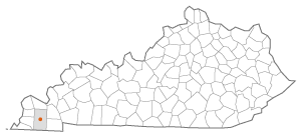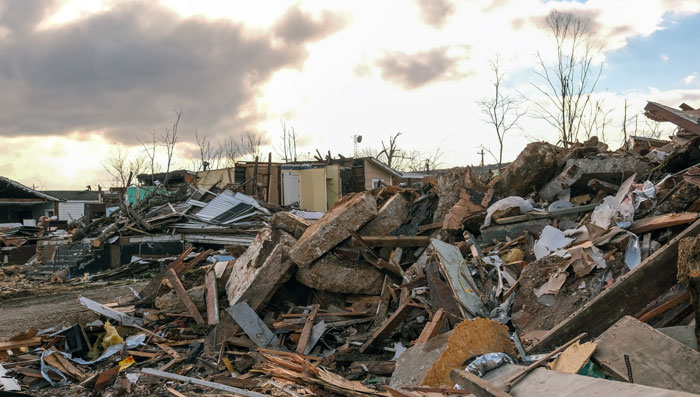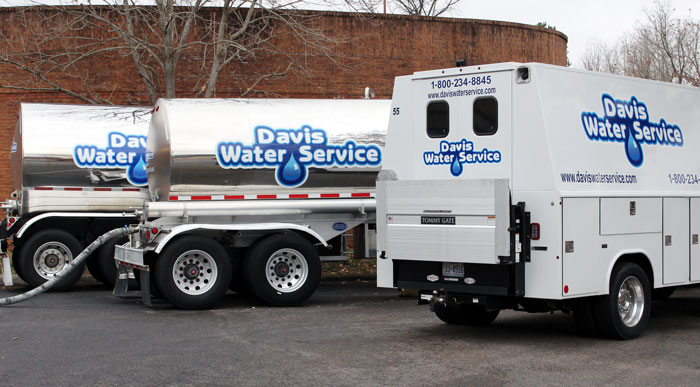Tornadoes Tear a Swath Through Western Kentucky Leaving Scores of Rural Communities in Need of Help
What Happened

What should have been a happy season leading up to the holidays was shattered for rural Kentuckians when a surprising late-season storm hit on Friday, December 10, 2021. The parent supercell storm produced two EF4 tornadoes, eleven tornadoes in total, and later became known as the “Quad-State supercell.” Tornadoes are measured on the Enhanced Fujita (EF) scale according to wind damage. The scale rates tornadoes from EF0 with minimal damage to an EF5 causing incredible damage.

One of the violent tornadoes rumbled across western Kentucky during the night for three hours and traveled 160 miles. With wind speeds of between 116 to 200 miles per hour, the EF4 tornado inflicted catastrophic damage in numerous communities in its path, including Bowling Green, Bremen, Cayce, Dawson Springs, Mayfield, and Princeton.
The destruction also included the collapse of a candle factory in Mayfield, Kentucky, whose night shift was in operation, resulting in 8 deaths.
For the month of December, this was the deadliest tornado outbreak in the nation on record and caused the destruction of more than 15,000 buildings and approximately 80 deaths. Over a quarter of those fatalities occurred in Graves County, the location of Mayfield, the candle factory, and Jackson Purchase Medical Center (JPMC).
After the storm had passed, the widespread destruction and sheer number of injured citizens required an extensive emergency response, made up largely of small rural hospitals, emergency medical services (EMS), and disaster personnel. The response was supported by existing relationships and collaborative partnerships to get resources where they were needed.
Planning
Prepared and ready to assist that night was the Emergency Support Function (ESF) 8 headed by the Kentucky Department for Public Health (DPH), according to BJ Newbury, Readiness and Response Coordinator, West Kentucky Healthcare Coalition, Kentucky Department for Public Health. ESF 8 is 1 of 15 ESFs within the emergency preparedness and response structure utilized for disaster response. DPH coordinates public health and medical-related preparedness, response, and recovery activities for emergencies, disasters, exercises, or planned events requiring state-level coordination. The Kentucky Hospital Preparedness program, under the Public Health Preparedness Branch in DPH, comprises 8 regional coalitions with participants from EMS, hospitals, local health departments, emergency management agencies, long-term care facilities, and others.
In addition, the West Kentucky Healthcare Coalition (WKYHCC) assisted with coordinating the healthcare coalition's response on the night of December 10, 2021. WKYHCC is a collaborative effort of 16 local hospitals, emergency managers, and EMS providers from the 24 counties in far western Kentucky.
Many of the hospital administrators, such as chief executive officer (CEO) Dave Anderson at JPMC in Mayfield, Kentucky, and other responders are members of WKYHCC and pointed to their last 2 years of collaboration around the pandemic as practice for the night of the tornado. During the pandemic, and with the assistance of the Kentucky Hospital Association (KHA), the region facilitated weekly or bi-weekly CEO and chief medical officer (CMO) calls based on the severity of COVID infection rates in the region. These calls were the impetus for the WKYHCC COVID-19 surge plan. The surge plan outlined processes that were used for patient load balancing during the pandemic. The plan starts with a county emergency manager contacting the WKYHCC coordinator. The WKYHCC coordinator then sends a ReadyOp Alert notifying hospitals, EMS, and emergency managers of a situation.
During the tornado, McCracken County Emergency Management notified the WKYHCC coordinator of a major storm threat at 9:40 p.m. At 9:53 p.m., WKYHCC sent a ReadyOp Alert to its members, detailing the storm's approach and the risk of storm-related fatalities, prompting the hospital WKYHCC members to do a bed availability update and prepare for a potential patient surge. Hospitals used an online emergency management system to share information in real time and via alerts.
With the help of Newbury, JPMC in Mayfield and other first responder partners in Mayfield and Graves Counties worked together to use protocols and procedures from the preparedness plan.
Anderson also pointed to the mass casualty tabletop exercises his facility held in the past — sometimes internally and sometimes in coordination with other agencies — as helpful practice for the tornado response. “It was good to have gone through those exercises and regularly stretched those muscles,” said Anderson.
Response
At JPMC, Anderson activated the emergency response plan to make sure the hospital was prepared to respond to the needs of the community during the storm. JPMC has 107 beds and is the only healthcare facility in Graves County that provides acute care. JPMC provides healthcare services for patients in an 8-county region that makes up the Jackson Purchase, an area of Kentucky delineated by the Mississippi River to the west, the Ohio River to the north, and the Tennessee River to the east. The response began almost immediately after the storm had passed. Other rural hospitals (including those from the communities impacted by the storm and those that were not), EMS, emergency preparedness partners, and law enforcement all came together to coordinate the response.
As mentioned above, this group's partnership had been built long before the December tornadoes and was put to the test during the COVID-19 pandemic. David Anderson, CEO of JPMC, commented, “If the first time you contact another organization is after 9 o'clock at night after the tornado has passed, it's not going to work.”
Anderson described the COVID calls as a central experience that built collaboration and support among all partners. “It was common sense — they were all our patients, let's take care of them,” he said. That sentiment carried over into the tornado response, he explained: “No white flags, until we all have to wave together.”
In a 2021 Murray Ledger & Times article, MCCH, EMS Step up to Help Neighbors after Tornado, Jerry Penner, the CEO of Murray-Calloway County Hospital, a Critical Access Hospital (CAH) in the region, described the response coordination efforts among healthcare organizations. “Probably within moments of the tornado striking, I reached out to Dave Anderson, CEO of Jackson Purchase Medical Center,” Penner said. “He and I are friends, and over this COVID time, all local CEOs have gotten pretty close to help one another. It is no longer competition; sometimes you've just got to know when help is needed.” They discussed what resources might be needed in different locations, current needs of their facilities, and solutions to make room for the continuously arriving patients in need of triage and treatment. Both then decided to open their day surgery centers to create available bed space.
JPMC had avoided the damage that the tornado had inflicted on the heart of Mayfield, located south of the hospital, but the Graves County EMS station, which also housed the Mayfield Fire Department, was destroyed. In addition to Murray-Calloway County Hospital, 11 of the 16 regional hospital WKYHCC members received a surge of almost 500 patients who were affected by the tornado, and 7 additional patients were treated at a Tennessee hospital. Newbury said that what was even more impressive about the management of the patient surge caused by the storm was that each hospital was at the brink of capacity because of the Omicron COVID surge they were already handling.
Another challenge that made the response difficult was the high winds that continued until late morning the following day. Not only were life flights grounded, according to Newbury, but ground ambulances had difficulty navigating downed power lines, trees, and major debris, which made it difficult to get to victims and transport them for treatment.
Getting Resources to Where the People Were
As the storm moved across the state, Newbury received correspondence from crews that planned to deploy to the highly affected area after the tornado passed, but the tornado remained on the ground. EMS to the east of Mayfield started to see major damage and fatalities, and the response shifted. Even though the storm created havoc and put enormous pressure on partners throughout the emergency response system, they agreed that all responders worked well together.
Anderson said the response worked so well because people were “all in for the mission.” He said that he did not make a single call out to ask staff to report to the hospital; every time he needed a resource, that person showed up. Staff who had already worked a full shift that day came back in and the wound care nurse practitioner worked to collaborate with the surgical area, for example. The power went out at the hospital and, even with a generator, systems had to be rebooted. To that end, teleradiology became backed up, so the orthopedic surgeon walked back and forth from patient to patient reading the studies so that treatment could be initiated. Many of JPMC's doctors came in to help and said, “Where do you need me?” Anderson described the scene as “calm professionals doing what needed to be done.”
In fact, the tornado had wiped out power through entire communities leaving people in total darkness, except for vehicle lights. In the center of Mayfield, at the fire station near the courthouse, a single light was visible. Dazed and looking for help, community members began moving toward that light. The group that congregated, numbering more than 100, were wet, muddy, and bloody, with injuries of varying severity. The Mayfield fire chief reached out to Anderson, pleading for someone to come and do on-scene triage of the injured.
Anderson remembers starting to text, “I don't have anyone to send you.” He looked at that text and thought to himself, “Dig deeper.” A few moments later, he received a call from a physician who was heading to the hospital and asked him to divert to the triage site. With Anderson's assistance on navigating around the debris field to get to the location, the physician arrived within 25 minutes of the call going out. Anderson considers that moment a successful out-of-hospital intervention.
Additionally, due to the power outage and having to rely solely on emergency power, the hospital lost many of the systems needed to reliably document the care that was delivered. Those patient records had to be built and added to. That made it difficult to accurately account for the care provided and meant that revenue capture had to be figured out on the back end. Anderson emphasized, though, that in the crisis, taking care of the patients mattered most.
One of the other needs that arose, which may not be apparent in emergency preparations, was the need for water. The fire chief called, needing water for the patients coming into their location who were covered in debris and mud. Realizing that he did not have enough water and thinking there had to be water somewhere, Anderson reached out to the superintendent of schools thinking he might have a resource and asked him to send as much as he could. Within a few minutes, the superintendent responded with a source and asked how to get it there, and together they navigated the water to where it was needed.
By the time the light broke the next morning, JPMC had cared for approximately 85 patients in a little more than 12 hours and more than 110 patients by the time the storm was over. Anderson reflected that, during that short window, they had taken care of almost one and half times the number of patients they typically see in a 24-hour period. Reflecting on the onslaught of patients, Anderson shuddered to think what might have happened if the tragedy at the collapsed candle factory had been even worse than it had been.

Helping to accelerate the recovery of services at the hospital was the quick response of LifePoint Health system, of which JPMC is part. Anderson commented that, by the morning after the storm, LifePoint had brought in a mobile generator large enough to power the entire hospital. Not long after that, they had hooked up an 8,000-gallon tanker to the back of the hospital to restore water in the facility.
In addition, because it was so close to Christmas, the Life Care Disaster Recovery Program aided employees by providing assistance with gifts for Christmas. Anderson said that he was touched by all of the colleagues from the system who called, reached out, and got together and shopped to make Christmas happen for employees who were affected by the storm.
Recovery
While the wind from the tornado caused visible damage and destruction, these physical structures and property that were destroyed could be rebuilt. It was some of the more invisible damage that Anderson said the community has come together to address.
In the weeks after the tornado, the community of Mayfield undertook a new initiative to rebuild. Part of the Rebuild Mayfield initiative included a health and wellness committee who was charged with assisting in addressing the mental health needs in the community. Anderson described the next steps in recovery. Outpatient psychiatric care has always been difficult to come by in rural Kentucky, but the storm left people, especially children, in fear and dealing with tremendous loss. He pointed to a survey of third graders, conducted by Rebuild Mayfield, to find out what they would like to see in the community as the rebuild continued. The #1 thing that they wanted to see in the community was a safe place to go in a storm.
After the storm threat had passed and the rebuilding had begun, the KHA held a virtual call on December 13 with all the hospitals in western and southwest Kentucky to ask how KHA could help with recovery both within the hospitals and the communities.
Usually in a crisis, first responders work on a contained emergency with a limited scene. One thing that fire and other emergency personnel commented on during the debrief was that it is different when the situation is widespread and impacts their own homes, families, and neighbors. When buildings and equipment take a direct hit and the need for a response isn't over, the situation becomes more dire. It is critical that there are partnerships and protocols in place to lend support to neighboring communities.
As JPMC quickly found out, necessities like power and water are key to rebuilding the healthcare infrastructure and returning to “normal” operations in order to continue to provide crucial services to the communities and populations they serve. Restoring basic services as quickly as possible may require considerable external support and collaboration.
Another thing that is not always accounted for when planning for disaster, according to Newbury, is all of the healthcare personnel and first responders who are also impacted by the storm and who continued to work at the hospital or in the initial EMS response, with their homes devastated and families displaced. Some responders were unable to locate their families and communications were down, but they continued working to provide services and care and support recovery.
To meet the behavioral health needs of the community and hospital staff after the tornado, JPMC expanded its employee assistance resources and services with assistance from LifePoint Health system.
Anderson concluded, “In a rural community, never take partners for granted. Not law enforcement, post-acute, fire, EMS…In unison, we can stand up and get at an issue.”
Person(s) Interviewed
Dave Anderson, Chief Executive Officer
Jackson Purchase Medical Center
BJ Newbury, Readiness and Response Coordinator, West Kentucky Healthcare Coalition
Kentucky Department for Public Health
Opinions expressed are those of the interviewee(s) and do not necessarily reflect the views of the Rural Health Information Hub.
